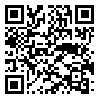Volume 22, Issue 1 (Mar-Apr 2014)
JSSU 2014, 22(1): 850-857 |
Back to browse issues page
Download citation:
BibTeX | RIS | EndNote | Medlars | ProCite | Reference Manager | RefWorks
Send citation to:



BibTeX | RIS | EndNote | Medlars | ProCite | Reference Manager | RefWorks
Send citation to:
Nowrozi H, kazemi A. The Effect of Ultraviolet (UV) Radiation Duration on Drug Susceptibility Testing of Rhizopus spp. to Amphotericin B, Itraconazole and Fluconazole. JSSU 2014; 22 (1) :850-857
URL: http://jssu.ssu.ac.ir/article-1-2477-en.html
URL: http://jssu.ssu.ac.ir/article-1-2477-en.html
Abstract: (8820 Views)
Introduction: Ultraviolet (UV) radiation is used as a disinfectant in laboratories and hospitals which its efficacy level depends on duration of radiation. Therefore, this study was done to evaluate the duration of UV radiation effect on drug susceptibility testing of Rhizopus spp. to amphotericin B, itraconazole and fluconazole.
Methods: This cross- sectional study was conducted on 12 clinical strains isolated from patients according to CLSI M38-P method. Initially, fungal suspensions were supplied with cell ranges of 0.5-5×104cfu/ml . Then, drug stocks of itraconazole and amphotericin B with serial dilution of 0.03125-16 µg/mlas well as fluconazole of 0.125-64µg/ml were prepared. Drug susceptibility was scrutinized pre and post UV radiation after 1, 2, 5,10,60,90 and 120 s of UV radiation.
Results: The highest and lowest MICs were 64µg/ml and 0.5 µg/ml for amphotericin B and fluconazole pre UV radiation, respectively. After UV radiation, MICs gradually decreased so that after 10 s of UV radiation, MICs were <0.03125 which were considered 0. MICs of mentioned drugs significantly decreased with increasing UV radiation of more than 2 s duration compared to pre UV radiation (P< 0.05).
Conclusion: UV radiation use with proper radiation time is recommended for prevention of nosocomial fungal infection.
Type of Study: Original article |
Subject:
Pharmacology
Received: 2013/07/16 | Accepted: 2014/01/12 | Published: 2014/02/5
Received: 2013/07/16 | Accepted: 2014/01/12 | Published: 2014/02/5
Send email to the article author
| Rights and permissions | |
 |
This work is licensed under a Creative Commons Attribution-NonCommercial 4.0 International License. |





